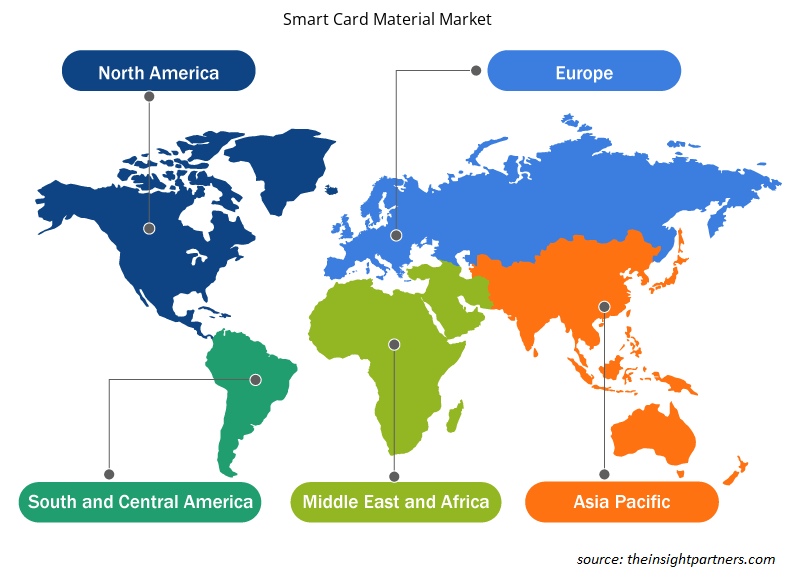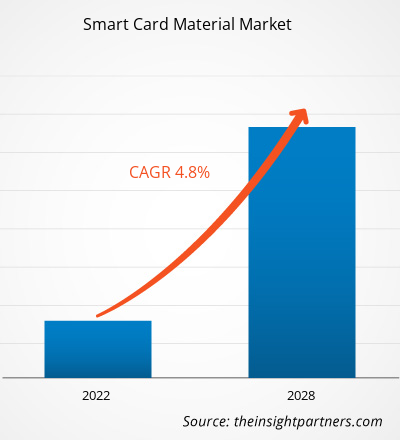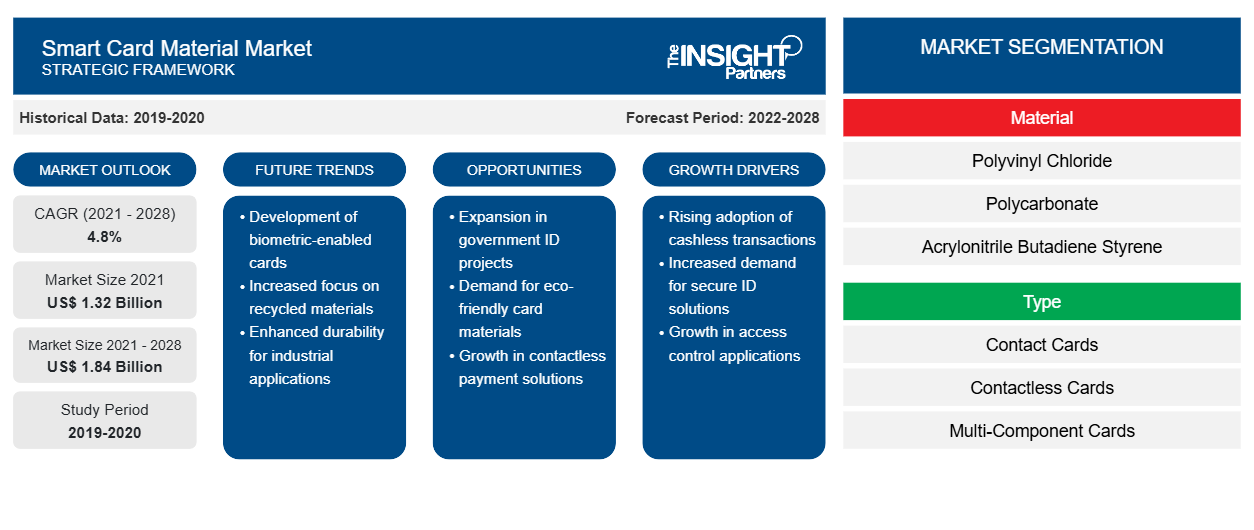Der Markt für Chipkartenmaterial soll von 1.324,57 Millionen US-Dollar im Jahr 2021 auf 1.837,78 Millionen US-Dollar im Jahr 2028 anwachsen; von 2021 bis 2028 wird mit einer durchschnittlichen jährlichen Wachstumsrate von 4,8 % gerechnet.
Eine Smartcard, eine Art Chipkarte, ist eine Plastikkarte, die einen eingebetteten Computerchip enthält, entweder einen Speicher- oder einen Mikroprozessortyp, der Daten speichert und überträgt. Diese Daten sind normalerweise entweder mit Werten oder Informationen oder beidem verknüpft, die im Chip gespeichert und verarbeitet werden. Smartcard-Materialien beziehen sich auf chemische Materialien, die bei der Herstellung dieser Karten verwendet werden. Diese Materialien unterstützen das Einbetten und Drucken von Informationen auf ihnen.
Im Jahr 2020 hatte der asiatisch-pazifische Raum den größten Anteil am globalen Markt für Chipkartenmaterialien . Die Nachfrage nach Chipkartenmaterialien in dieser Region steigt aufgrund der zunehmenden Verwendung von Chipkarten im Telekommunikationssektor. Darüber hinaus sind der zunehmende Globalisierungstrend und die florierende Banken-, Finanzdienstleistungs- und Versicherungsbranche (BFSI) Schlüsselfaktoren, die das Wachstum des Marktes für Chipkartenmaterialien in der Region begünstigen.
Passen Sie diesen Bericht Ihren Anforderungen an
Sie erhalten kostenlos individuelle Anpassungen an jedem Bericht, einschließlich Teilen dieses Berichts oder einer Analyse auf Länderebene, eines Excel-Datenpakets sowie tolle Angebote und Rabatte für Start-ups und Universitäten.
-
Holen Sie sich die wichtigsten Markttrends aus diesem Bericht.Dieses KOSTENLOSE Beispiel umfasst eine Datenanalyse von Markttrends bis hin zu Schätzungen und Prognosen.
Auswirkungen der COVID-19-Pandemie auf den Markt für Smartcard-Material
Die anhaltende COVID-19-Pandemie hat den Status des Chemie- und Materialsektors drastisch verändert und das Wachstum des Marktes für Chipkartenmaterialien beeinträchtigt. Der deutliche Leistungsrückgang mehrerer Industriezweige hat die Nachfrage nach Chipkartenmaterialien beeinträchtigt. Die Auswirkungen der Pandemie sind in den verschiedenen Anwendungssegmenten unterschiedlich. Ein Anstieg des Datenverkehrs und der Sprachdienste hat vielen Telekommunikationsunternehmen, darunter Breitband- und Mobilfunkbetreibern, zugutegekommen. Die von den Regierungen verhängten Lockdown-Maßnahmen störten jedoch die Lieferketten für Rohstoffe wie PVS, ABS und PETG, die für die Herstellung von Chipkarten benötigt werden. Die Ausbreitung der Krankheit hat sich negativ auf die Aktivitäten im Regierungs- und BFSI-Sektor ausgewirkt. Da die Volkswirtschaften jedoch planen, ihre Aktivitäten wieder anzukurbeln, wird erwartet, dass die Nachfrage nach Chipkartenmaterialien in den kommenden Jahren weltweit steigen wird.
Markteinblicke
Deutliches Wachstum in den Bereichen Telekommunikation und Gesundheitswesen
Smartcards werden in der Telekommunikationsbranche häufig verwendet. Die bekannteste Verwendung von Smartcards in diesem Sektor ist die Verwendung als SIM-Karten (Subscriber Identity Module) oder UICC-Karten (Universal Integrated Circuit Cards). Diese Smartcards werden hauptsächlich aus Polyvinylchlorid (PVC) und Acrylnitril-Butadien-Styrol (ABS) hergestellt. Die in diesem Sektor verwendete Smartcard-Technologie hat in den letzten Jahren kontinuierliche Fortschritte gemacht, was den Einsatz dieser Karten erhöht hat. Darüber hinaus implementieren Gesundheitsorganisationen auf der ganzen Welt Smart-Gesundheitskarten mit einer breiten Palette an Funktionen und Anwendungen.UICC). These smart cards are manufactured mostly from polyvinyl chloride (PVC) and acrylonitrile butadiene styrene (ABS) materials. The smart card technology used in applications in this sector has undergone continuous advancements in the last several years, which has boosted the consumption of these cards. Further, healthcare organizations across the world are implementing smart health cards with a wide range of features and applications.
Regionale Einblicke in den Markt für Chipkartenmaterialien
Die regionalen Trends und Faktoren, die den Markt für Chipkartenmaterial im Prognosezeitraum beeinflussen, wurden von den Analysten von Insight Partners ausführlich erläutert. In diesem Abschnitt werden auch die Marktsegmente und die Geografie von Chipkartenmaterial in Nordamerika, Europa, im asiatisch-pazifischen Raum, im Nahen Osten und Afrika sowie in Süd- und Mittelamerika erörtert.

- Erhalten Sie regionale Daten zum Markt für Chipkartenmaterialien
Umfang des Marktberichts zu Chipkartenmaterialien
| Berichtsattribut | Details |
|---|---|
| Marktgröße im Jahr 2021 | 1,32 Milliarden US-Dollar |
| Marktgröße bis 2028 | 1,84 Milliarden US-Dollar |
| Globale CAGR (2021 - 2028) | 4,8 % |
| Historische Daten | 2019-2020 |
| Prognosezeitraum | 2022–2028 |
| Abgedeckte Segmente |
Nach Material
|
| Abgedeckte Regionen und Länder |
Nordamerika
|
| Marktführer und wichtige Unternehmensprofile |
|
Marktdichte von Chipkartenmaterialien: Auswirkungen auf die Geschäftsdynamik verstehen
Der Markt für Chipkartenmaterial wächst rasant. Dies wird durch die steigende Nachfrage der Endnutzer aufgrund von Faktoren wie sich entwickelnden Verbraucherpräferenzen, technologischen Fortschritten und einem größeren Bewusstsein für die Vorteile des Produkts vorangetrieben. Mit der steigenden Nachfrage erweitern Unternehmen ihr Angebot, entwickeln Innovationen, um die Bedürfnisse der Verbraucher zu erfüllen, und nutzen neue Trends, was das Marktwachstum weiter ankurbelt.
Die Marktteilnehmerdichte bezieht sich auf die Verteilung der Firmen oder Unternehmen, die in einem bestimmten Markt oder einer bestimmten Branche tätig sind. Sie gibt an, wie viele Wettbewerber (Marktteilnehmer) in einem bestimmten Marktraum im Verhältnis zu seiner Größe oder seinem gesamten Marktwert präsent sind.
Die wichtigsten auf dem Markt für Chipkartenmaterialien tätigen Unternehmen sind:
- Eastman Chemical Company
- PetroChina Company Limited
- Solvay SA
- KEM EINS
- SABIC
Haftungsausschluss : Die oben aufgeführten Unternehmen sind nicht in einer bestimmten Reihenfolge aufgeführt.

- Überblick über die wichtigsten Akteure auf dem Markt für Smartcard-Materialien
Anwendungseinblicke
Basierend auf der Anwendung ist der Markt für Chipkartenmaterial in BFSI, Regierung, Telekommunikation, Einzelhandel, Gesundheitswesen, Gastgewerbe und andere unterteilt. Das Telekommunikationssegment hielt im Jahr 2020 den größten Anteil am Markt für Chipkartenmaterial. Chipkarten werden als Prepaid-Telefonkarten (Wertkarten) und mikroprozessorbasierte Chipkarten-SIM-Karten oder UICC in Mobiltelefonen verwendet. Die meistverkauften Chipkartenprodukte in diesem Sektor sind SIM und UICC, gemessen an Menge und Wert.
Zu den Akteuren auf dem globalen Markt für Smartcard-Materialien gehören unter anderem Eastman Chemical Company, PetroChina Company Limited, Solvay SA, KEM ONE, SABIC, 3A Composites GmbH, Teijin Limited, LG Chem, BASF SE und Westlake Chemical Corporation.
Bericht-Spotlights
- Fortschrittliche Branchentrends auf dem Markt für Chipkartenmaterialien helfen den Akteuren bei der Entwicklung wirksamer langfristiger Strategien
- Geschäftswachstumsstrategien von Unternehmen in Industrie- und Entwicklungsmärkten
- Quantitative Analyse des Marktes für Chipkartenmaterialien von 2019 bis 2028
- Schätzung der weltweiten Nachfrage nach Chipkartenmaterialien
- Porters Fünf-Kräfte-Analyse zur Veranschaulichung der Wirksamkeit der in der Branche tätigen Käufer und Lieferanten
- Aktuelle Entwicklungen zum Verständnis des wettbewerbsorientierten Marktszenarios
- Markttrends und -aussichten sowie Faktoren, die das Wachstum des Marktes für Chipkartenmaterialien vorantreiben und bremsen
- Unterstützung im Entscheidungsprozess durch Aufzeigen von Marktstrategien, die das kommerzielle Interesse untermauern und zum Wachstum des Marktes für Chipkartenmaterialien führen
- Die Größe des Marktes für Chipkartenmaterial an verschiedenen Knotenpunkten
- Detaillierte Übersicht und Segmentierung des Marktes sowie der Dynamik der Chipkartenmaterialindustrie
- Größe des Marktes für Chipkartenmaterialien in verschiedenen Regionen mit vielversprechenden Wachstumschancen
Markt für Chipkartenmaterialien
Nach Material
- Polyvinylchlorid (PVC)
- Polycarbonat (PC)
- Acrylnitril-Butadien-Styrol (ABS)
- Polyethylenterephthalatglykol (PETG)
- Sonstiges
Nach Typ
- Kontaktkarten
- Kontaktlose Karten
- Mehrkomponentenkarten
Nach Anwendung
- BFSI
- Regierung
- Telekommunikation
- Einzelhandel
- Gesundheitspflege
- Gastfreundschaft
- Sonstiges
Firmenprofile
- Eastman Chemical Company
- PetroChina Company Limited
- Solvay SA
- KEM EINS
- SABIC
- 3A Composites GmbH
- Teijin Limited
- LG Chem
- BASF SE
- Westlake Chemical Corporation
- Historische Analyse (2 Jahre), Basisjahr, Prognose (7 Jahre) mit CAGR
- PEST- und SWOT-Analyse
- Marktgröße Wert/Volumen – Global, Regional, Land
- Branchen- und Wettbewerbslandschaft
- Excel-Datensatz
Aktuelle Berichte
Erfahrungsberichte
Grund zum Kauf
- Fundierte Entscheidungsfindung
- Marktdynamik verstehen
- Wettbewerbsanalyse
- Kundeneinblicke
- Marktprognosen
- Risikominimierung
- Strategische Planung
- Investitionsbegründung
- Identifizierung neuer Märkte
- Verbesserung von Marketingstrategien
- Steigerung der Betriebseffizienz
- Anpassung an regulatorische Trends























 Kostenlose Probe anfordern für - Markt für Smartcard-Materialien
Kostenlose Probe anfordern für - Markt für Smartcard-Materialien